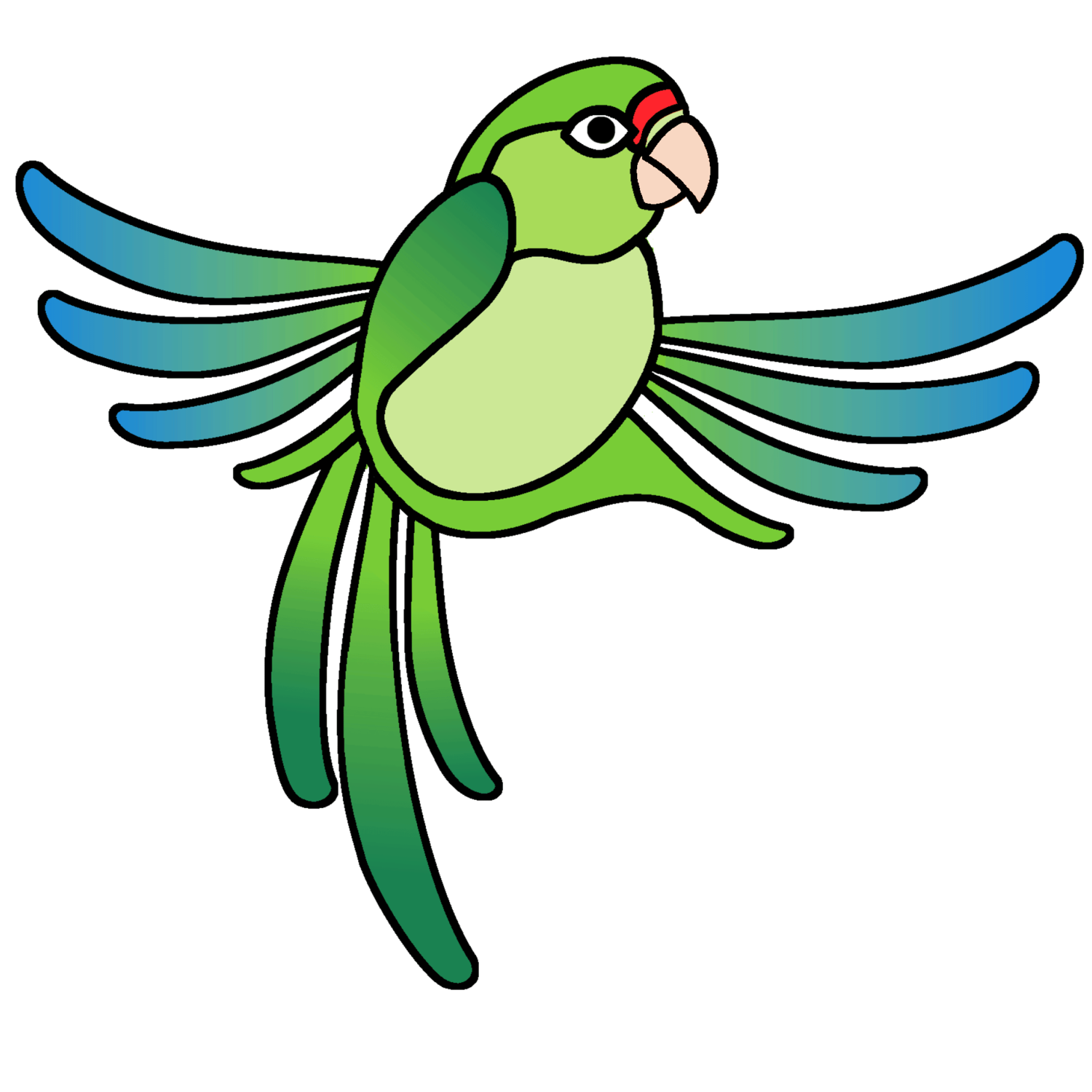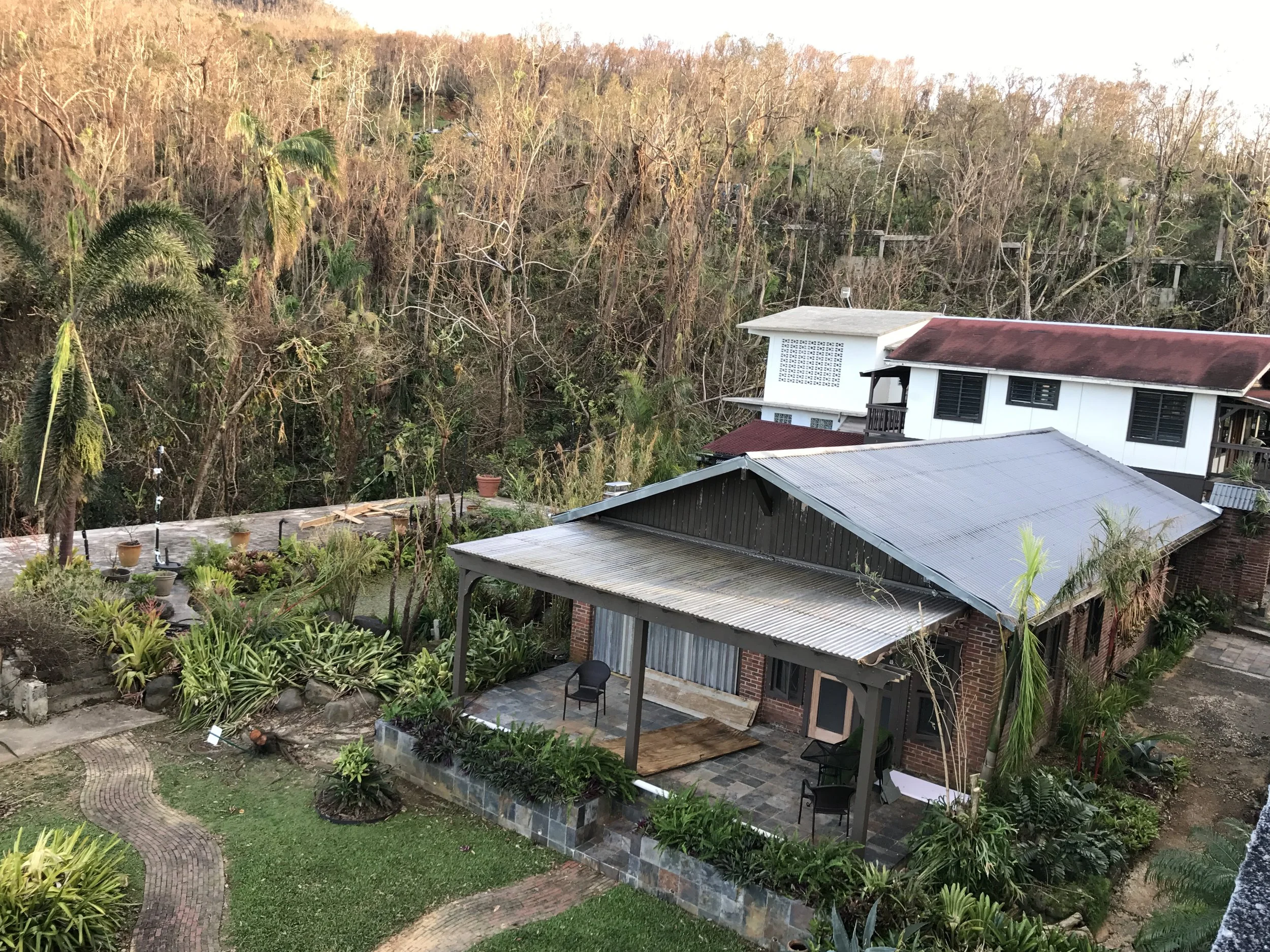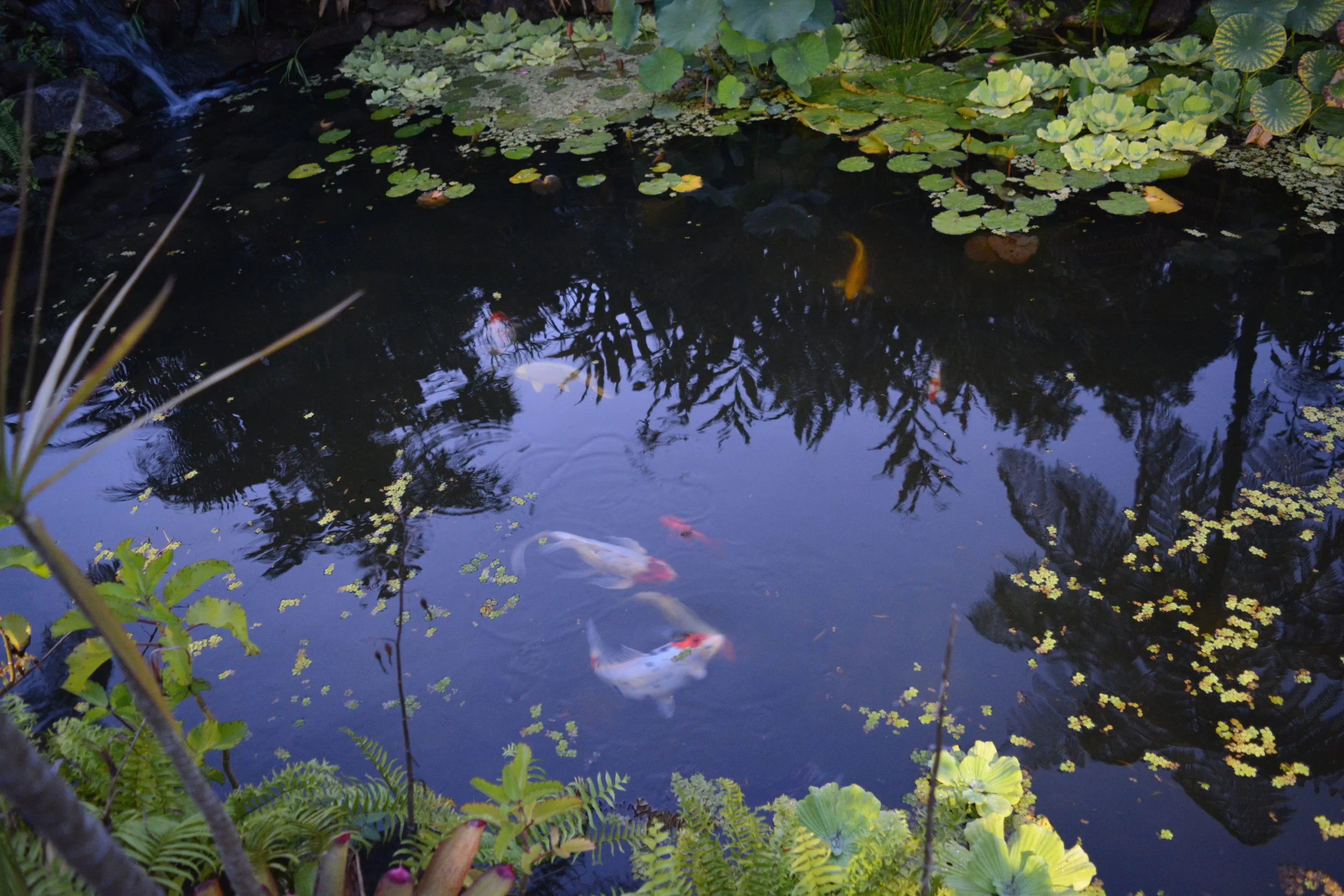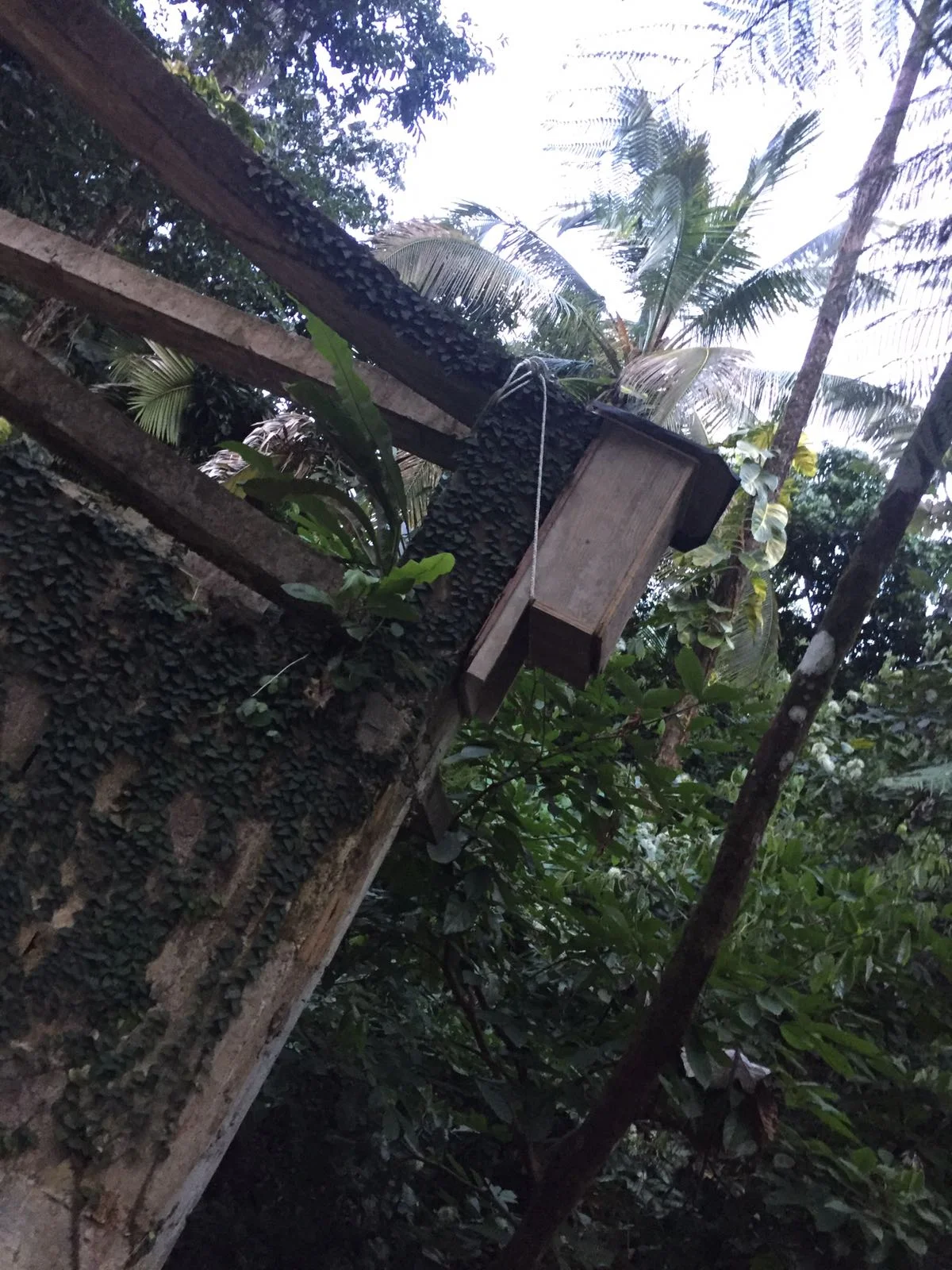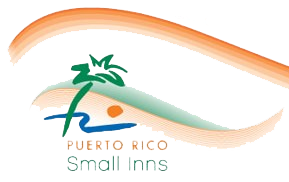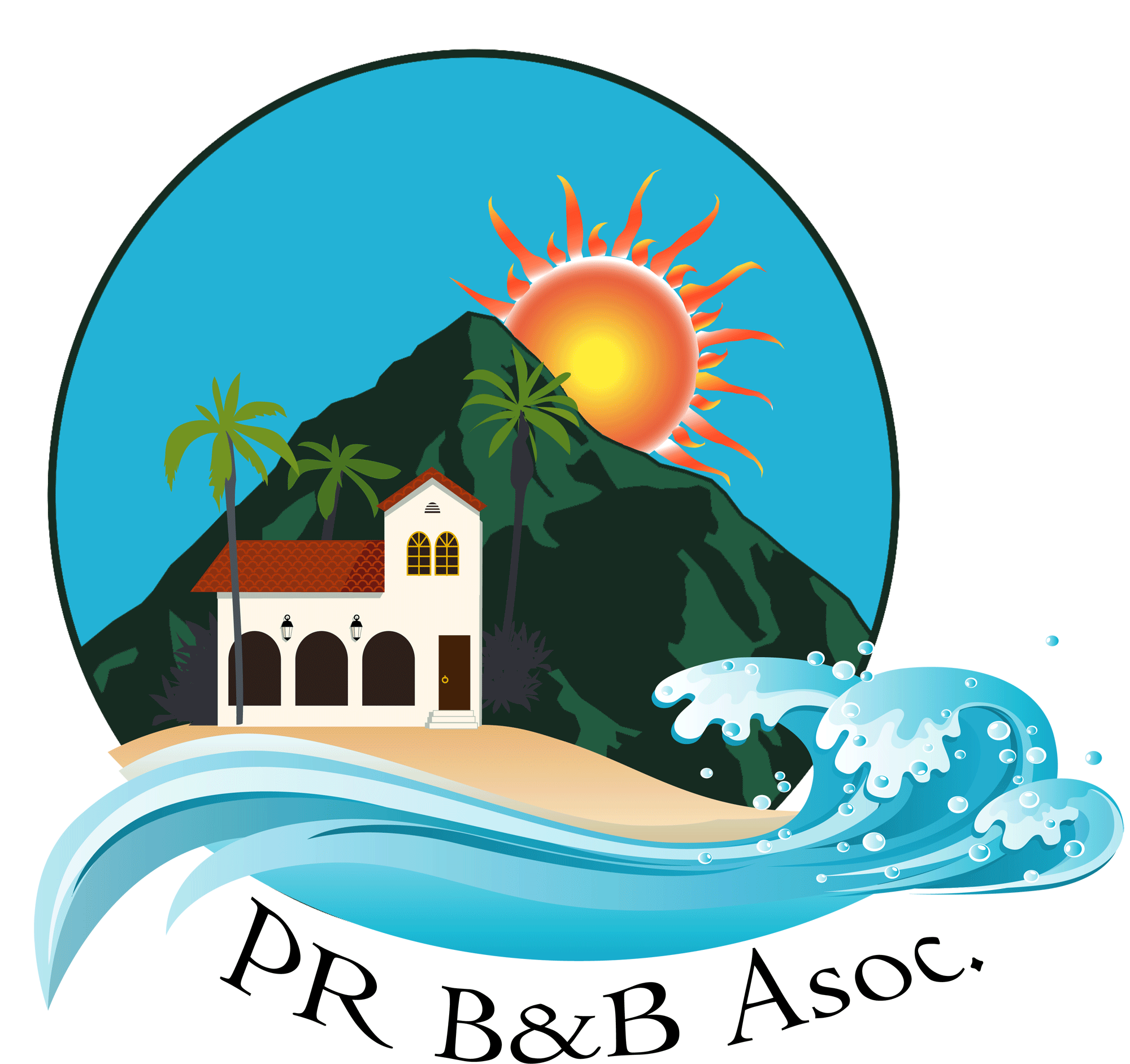The Rainforest Inn's private trail into the El Yunque jungle is the only access we know of that is completely private, open only to our guests, and which features both an amazing deep pool and a spot to pitch hammocks near the waterfall.
Christmas in Puerto Rico after Hurricane Maria
Christmas ( Tres Reyes ) in Puerto Rico after hurricane Maria will be different but, as always, it is about the children.
Relax at the Rainforest Inn
Uncrowded Paradise
Project Loon over Puerto Rico
project loon has come to Puerto Rico and looks like shiny flying saucers up in the sky over El Yunque.
Everything is Coming together Now
Our private hike "the lost machete trail" needed to be cleared of felled trees and brush after hurricane Maria.
Surviving Hurricane Maria
Fresh Papaya for breakfast
We are lucky to have a couple of papaya plants that we grew from a Hawaiian papay seed. It is a delicious tasting papaya that has hints of floral and none of the strong smell of ordinary papayas.
The best way to pick papayas is with a tall ladder. If you use a fruit picker pole you risk damaging the soft ripe fruit.
Our Koi and Plans for the Pond
Our Bat Homes
Rainforest Inn was Awarded Small Green Hotel of the Year!
Just after award ceremony at the Condado Plaza Hotel.
We at the Rainforest Inn have been working very hard to be sustainable and to respect the rainforest environment that our inn shares. Tripadvisor has recognised us as a "Platinum" level green bed and breakfast. The Tourism Department of Puerto Rico has certified us as a "Sustainable Tourism Facility". And now the Puerto Rico Hotel and Tourism Association honoured us with the small green hotel of the year award.
We are so proud and we will never stop doing everything it takes to be sustainable in the El Yunque rainforest of Puerto Rico.
Revealing the Secrets of the Lost Machete Trail
Six young scientists showed up at our door, sweaty but cheery, after running down 2.5 kilometers from the nearby El Verde Field Station and then up our steep driveway that climbs over 172 meters in just 1.5 kilometers. The group, lead by the Luquillo Forest Dynamics Plot (LFDP) Project Manager Seth Rifkin, came to trek a few miles further into the rainforest to bestow their knowledge upon our private Lost Machete Trail hike. The researchers had been working at El Verde for sometime between a few weeks to a few months, and Rifkin has been there for eight years, so they know more about the trees in El Yunque than the average person knows about the far fewer species found in our North American forests.
Rifkin manages a 16-hectare study plot next to El Verde Field Station, which lies at about 350 meters elevation. The plot spans out over both forest that was never selectively cut as well as forest that had been used for agriculture until the mid-20th century, Rifkin said. The LFDP was established in 1990 to observe how the rainforest recovers from hurricane damage, specifically in the aftermath of hurricane Hugo in 1989. Every five years around 25 researchers, most commonly recent college graduates, live at the field station for anywhere from a few months to a year, working to collect data for the tree census. Their work entails hiking to various quadrants, through mud and streams and over steep hills, and measuring every tree stem at 130 centimeters from the ground that is more that one centimeter in diameter at that point and record the species and physical damage to the crown or trunk.
The data collected at the LFDP contributes to the Smithsonian’s Center for Tropical Forest Science - Forest Global Earth Observatory (CTFS - ForestGEO)—a global network of over 60 forest research plots across the Americas, Africa, Asia, and Europe reserved for the study of tropical and temperate forest function and diversity. CTFS-ForestGEO monitors the growth and survival of approximately 6 million trees and 10,000 species, in plots around the world that are varying sizes but use the same research methodology. The LFDP is affiliated with the University of Puerto Rico and funded by the National Science Foundation’s Long Term Ecological Research Program. The data collected by the El Verde crew goes into the ForestGEO database and is analyzed for factors that contribute to tree species community dynamics, how anthropogenic climate change is changing those dynamics, and other threats to species diversity.
“As the project was developing, they came to the realization that there was more of an effect of past human land-use patterns on the tree species composition then even the hurricane damage,” Rifkin said. “There is also an additive effect of those two types of disturbance to the tree species composition.”
The ForestGEO timeline is essentially indefinite, Rifkin said, as long as there are still forests to monitor. Luckily there are scientists who remain excited about measuring trees year after year, and were more than happy to explore the forests outside of their study plot.
The El Verde crew eagerly set off on our hike and returned a few hours later having only made it halfway to the natural pool at the summit because they ran out of sunlight. If you have ever hiked (or even stepped outside of your front door) with a biologist, you are privy to the fact that it takes significantly longer to go from point A to point B than it would with someone lacking training in ecology because a biologist will stop and gawk all eye-catching flora and fauna they pass. Given the biodiversity of El Yunque rainforest, our hike must have been a field day for the El Verde crew.
We sat down with Rifkin after the hike and he shared with us the knowledge that he and his colleagues noted about the trail; and it was a lot, because the tree species composition here is pretty similar to what the El Verde crew studies at the LFDP, Rifkin said. We also added some insight of our own and compiled a hike guidebook for our guests; here is a sneak peek...
Cecropia, known locally as Yagrumo hembra, is a genus consisting of 61 species; most common in El Yunque are Cecropia schreberiana (Pumpwood) and Cecropia peltata (Trumpet Tree or Snakewood). Cecropia are common in El Yunque because they are pioneer trees that establish abundantly after recurrent hurricane damage opens up the forest canopy and provides sun for the light-demanding tree. They are fast-growing, opportunistic trees that are one of the world's 100 most invasive alien species off the island, luckily they are native to Puerto Rico and are part of the rainforests’ strategy for hurricane recovery. Cecropia are easily distinguished by their large, deeply lobed leaf that looks like a hand and their white underbelly that shows when storm winds blow through the forest. The Taino word yagrumo means "two faced," which refers to the leaf faces’ mismatching colors. The leaves are steeped as tea used to treat kidney ailments and asthma, reduce pain and inflammation and kill bacteria and fungi.
Carrasco (Comocladia glabra) is a poisonous evergreen shrub in the same plant family as poison ivy, thus causing a similar skin reaction—and sometimes even more severe. It has a slender, unbranched trunk with large, lance-shaped spreading leaves, clusters of tiny dark red flowers and small reddish-black fruits. Its white sap turns black when exposed to air and is caustic, creating a painfully itchy rash that lasts several hours, sometimes days.
The Tree fern (Cyathea arborea) or Helecho arboreo in Spanish, has thrived since the era when dinosaurs roamed the earth. This perennial fern is successful in high-moisture environments and in colonizing landslides. Its crown has 10 or more fronds in the form of a fan, which each live for only 3 months but hold 3-5 billion spores for germination. When the tree fern is young, its fronds are rolled up. As they grow, each frond unrolls until it reaches its horizontal position.
Ficus Citrifolia, the Shortleaf or Strangler fig, is called Jagüey blanco in Spanish. The fig tree is an abundant tropical keystone species because figs are a major component of the diets of more species of animals than any other tropical perennial fruit, and because the hollow, lattice-like trunk provides a home for thousands of invertebrates, rodents, bats, birds and reptiles. Fig fruit turn from yellow to dark red when ripe, and are sweet and safe for human consumption. Fig begin their life as an epiphyte, a strategy which allows them to avoid competition for light by attacking palms and other trees, strangling them as it grows. The tiny epiphyte grows to an impressive height of 15 meters and covers a wide area due to their ability to drop aerial roots from branches and spread horizontally among the strangled parent tree. Ficus citrifolia is under strong selective pressure to flower and continuously produce fruit due to its mutualistic relationship with its specific species of pollinating fig wasp, which lays eggs in the fruit and acts as a pollinator for a specific species of fig. The fruit has a purgative effect on the digestive systems of animals that dine on it so its seeds are spread far and wide through dung.
Manilkara bidentata, Bulletwood or Ausubo, as it is most commonly called, is a large evergreen tree that was once one of the most important timber trees of Puerto Rico. In the Spanish colonial days it was cut down on the coast and its strong, highly valued wood was floated over to San Juan, where it was used as ceiling beams in many buildings still standing today in Old San Juan. Oxen also pulled carts laden with Ausubo beams over land to San Juan from El Yunque. Because it is extremely tolerant of shade, Ausubo is common in the lower elevations of El Yunque, where it can live up to 400 years. The tree is also tapped for its milky latex sap, the source of balata gum, which is sometimes used in products such as golf balls.
Prestoea acuminata var. Montana is the Sierra Palm, or Palma sierra. It is the most common tree in this elevation of El Yunque, succeeding where most trees cannot. Its distinguishing above-ground roots capture enough oxygen so that it can grow well in waterlogged soils. Thus, Sierra palms blanket steep slopes, unstable soils and high elevation streambeds. Very few other species of palm are found in the rainforest. Importantly, its fruit is the beloved Puerto Rican Parrot’s favorite food.
Pterocarpus officinalis is called either Palo de pollo or Sangre de drago. The most distinguishing feature of this impressive tree is its narrow, long buttresses (above-ground roots) that make the tree reminiscent of a palo de pollo—translated as “chicken stick” or “chicken foot.” The Palo de pollo buttresses, up to 4.5 meters tall, absorb oxygen in oxygen-poor soils such as in swamps and along streams. This evergreen tree grows, often twisted and fluted, to about 20-30 meters tall. When the bark is wounded it yields a copious amount of red sap that hardens into crimson “tears.” This is collected as sangre de drago, “dragon’s blood.” The sap is astringent and haemostatic—having the capability to close wounds and stop blood flow—and is used in the treatment of diarrhea, mouth sores and thrush. The tree has a large nitrogen-fixing capacity and provides vast shade for other flora such as coffee plants—both reasons that it survived subsistence coffee farmers years ago that cut down neighboring tropical hardwood trees to use as charcoal for the sugar cane refineries.
Swietenia macrophylla is called either Honduran or Big-leaf mahogany (Caoba de Honduras or de Hoja grande). Our mahogany trees were planted over 30 years ago to test a new design for mahogany plantations. Instead of initially clear cutting the forest plot with traditional slash and burn procedures, forestry scientists planted many rows of mahogany and applied defoliant spray during their early growth to discourage competition for sunlight from nearby trees. This species of mahogany is fast growing but not as dense or elegantly figured as the native mahogany, Swietenia mahagoni. Once mature, the seed of mahogany splits and falls to the ground as a beautiful flower-shaped woody structure.
Syzygium jambos is the Rose Apple. This tree is native to Southeast Asia and moderately invasive in Puerto Rico. The fruit is edible and has a strong floral aroma, earning its name of "rose apple" or pomarrosa. At the Rainforest Inn, we occasionally serve freshly picked pomarrosas from our trees with our breakfasts. The fruit is rich in vitamin C and can be eaten raw or used in various regional recipes. The wood is dense and is therefore a source of charcoal. Additionally, the tree contains various tannins that may have antimicrobial applications and some parts of the tree are used in regional traditional medicine.
These trees are tagged along the Lost Machete Trail to help our guests better understand and appreciate the rainforest in which they are vacationing. Our new hike guidebook is a part of our ecological signage around the inn that has helped us earn accreditation by the Puerto Rico Tourism Company’s Sustainable Tourism Facilities Program. We are excited to share the secrets of the Lost Machete Trail...and there are even more to come once the El Verde scientists return for part two of their quest to the beautiful private pool above the 70-foot waterfall at the trail’s end!
Bob's East Island Surfing Adventures
Bob gives directions on land before setting his surfers free in the water
La Pared beach, named for its colorful mosaic pared (wall) along the boardwalk, is a soft-sand inlet that Luquillo boasts as the surf and skate central of East Island Puerto Rico. When standing in front of el Monumento—the monument built in honor of the tiger shark that supposedly protects the beach—you have a flawless view to the east of the sunrise in the morning or the lighthouse and the distant haze of the Fajardo city lights at night. Straight ahead is the open Atlantic Ocean, and to the west lies the deepest point of the Atlantic— the Puerto Rico Trench. Following west along the coast, you pass the fortress-lined shores of San Juan and eventually arrive at Puerto Rico's famous surf destination, Rincon. But as Bob Roberts of Bob’s East Island Surfing Adventures said, Luquillo has everything a local or tourist needs to spend a day—or lifetime—at the beach.
Bob, Jeremy and Justo help students practice their stance and ready position
Bob owned and operated a surf shop in Luquillo in the 1980s with his wife Suzy and has stayed at the beach ever since. Within the past ten years he has shifted his business to instructing surfing adventures. His adventure starts out on la orilla (the shore) with 30 minutes of instruction on safety and surfing techniques. His instructors, Justo, Brad and Jeremy, help each student perfect their “ready position” and stance on the board and teach them how to paddle, stand up on the board and even the best way to fall off the board in a "wipe out" and how to escape a riptide. Then it is time to dive into el mar (the ocean) for 90 minutes of riding las ondas (the waves). The comfortably warm Caribbean sea at La Pared is perfect for low-intensity surfing because it only reaches a few feet deep by 100 meters out, so beginner surfers can catch the white waves, which indicate shallow water, or the intermediate-level green waves as the tide rises.
Justo and Jeremy await a big wave for the first-time surfers to ride
Bob reassures his students that although surfing is a difficult sport that takes years to master, the success rate of his beginner-to-intermediate level course is surprisingly high. Virtually all students catch at least a few waves and remain standing all the way to shore, as many of our guests have told us. Since some people need help just getting onto the board, while others are quickly ready to ride more challenging waves, Bob and his crew pride themselves on their personal approach to teaching that caters to all levels of surfers. Bob lectures and demonstrates the techniques excellently, even bilingually when necessary. All the instructors are genuinely encouraging and high-spirited; their love for the sport and Luquillo is apparent in their upbeat but laid-back instruction and bright expressions.
Because friends and family may have a hard time believing that you actually managed to ride a wave, Bob’s crew takes plenty of pictures of every student. They post on Facebook only the photos that make even the short bursts of beginner’s luck look like longer rides that come from years of experience.
With the perfect location and exceptional instruction, Bob’s East Island Surfing Adventures deserves the overwhelming praise it receives online from its customers. To reserve your lesson, call (or better yet, text since his phone is often just at the fringe of cell service) Bob at (787) 435-1760
Melina Devoney riding her first wave to "La Pared" in Luquillo Beach
Check out our Puerto Rico Travelcast (on iTunes or here) for an interview with Bob that goes deeper into his adventures in Puerto Rico and his surfing lessons.
Sunday evening at Hacienda Muñoz
Héctor Muñoz
Héctor Muñoz, the co-founder of Hacienda Muñoz in San Lorenzo, Puerto Rico, intently watched the timer on a handsome red stainless steel Bendig coffee roaster in Hacienda Muñoz’s Doppio Cafe. Because he roasts the coffee so dark, the beans must be released from the roaster at exactly the right instant or else the whole batch will burn, Muñoz explained. At that pivotal moment, he opened the roaster to release a waft of rich aroma into the roasting hut and a wave of perfectly toasted 100% arabica beans into the cooling mixer. He smiled as he scooped out a handful of beans for onlookers to taste. The bean, still warm, had a satisfying crunch and a toasted bitterness that left us craving an entire cup.
Hacienda Muñoz roasts have the mouthwatering piquant fragrance and sharp flavor that distinguishes traditional Puerto Rican coffee. Muñoz roasts and packs four varieties on property; House, Dark and Premium Dark as well as Traditional Puerto Rican coffee selected from beans grown in Yauco, Puerto Rico.
Coffee production is one of the newest additions to the original catering business that Muñoz and his mother Yiya began in 1999. Their hacienda has since grown to include Yiya’s Restaurant, Amanda’s Wood sports bar, Doppio Cafe, an event venue with a large patio and a guest villa all bordering the plantation. They established the plantation, which now boasts 74,000 coffee trees, in 2005 with the intention of creating jobs and empowering local farmers to help reinvigorate coffee cultivation in the area. Peacocks and chickens roam the property and the open architecture of the patio and buildings allows a 360 degree view of the lush rolling countryside dotted with rows of coffee trees.
Event Patio
Hacienda Muñoz is the closest coffee plantation and roasting house to the Rainforest Inn and provides a good reason to go on a picturesque hour-long drive through the El Yunque mountains. We made the trip on a Sunday intending to take their public coffee tour—which we later discovered only runs Wednesday through Saturday 10 am and 2 pm and by appointment only. Upon our arrival, we were graciously greeted by Joseph, the manager who, despite having a lot on his plate that afternoon, gave us a brief tour of the roasting house and restaurant. Since our initial plan was foiled, we could not pass up dinner at Yiya’s. As he did with many of his guests, Joseph checked in on us periodically to make sure everything was to our liking.
Yiya’s Restaurant provides an extensive and varied menu that features house specialties with a subtle spin on traditional Puerto Rican cuisine. We ordered the Filete de Salmón a la Parilla and the island’s esteemed dish mofongo, which surprised us with its smoked flavor and unique incorporation of ham in the plantain dough. The amiable waitress obliged to Bill’s request for a vegetarian version without blinking an eye and Renée concluded that the fried plantain tostones were the highlight of her meal. One of our interns, Chelsea, experienced her first ever monfongo since arriving in Puerto Rico. She ordered the chicken version and especially enjoyed its smoky ham flavor and the salsa criolla; the mofongo is topped with either this tomato-based sauce or a garlic sauce called salsa al ajillo. Another one of our interns, Mel, ordered the Lover’s Drink; a strawberry, piña colada and mango-layered frapé. Though she was reluctant at first to take a sip and disturb the artful layers, Mel slurped down the frapé in a matter of minutes once she dared a taste.
Chelsea's Mofongo
Lover's Drink
Our after-dinner coffee was a perfect finale to the outing. Bill ordered a cappuccino which, because of the generous portion of milk in the espresso, made for a satisfying drink closer to the traditional Puerto Rican café con leche. Mel ordered an americano and was pleased that she could recognize the distinct Puerto Rican flavor of the fresh dark roasted coffee beans. After tasting the final product, we cannot wait to get a look behind the scenes of Hacienda Muñoz coffee on their tour, and we will be sure to recommend our guests take the scenic trip and plan to spend an entire day at Hacienda Muñoz.
Americano
Cappuccino
With our remarkable biowarfare, there are very few mosquitoes at the Rainforest Inn
"Our koi pond attracts dragonflies and houses fish that eat the mosquitoes"
Some of our guests have inquired about mosquito-borne diseases such as dengue. Despite our highly effective natural mosquito abatement program we like to call: “bio-warfare”, this worry has spoiled some of our guest’s vacations leading to cancellations because of the apprehension surrounding the possibility of Zika or dengue because of the assumption that there must be a high prevalence of mosquitoes at the Rainforest Inn, given its location within the El Yunque National Forest jungle. However, this is not true because this very jungle is teeming with various small creatures that diligently prey on every mosquito in sight.
Dengue is a mosquito-borne disease. The Dengue viruses are spread to people through the bite of an infected Aedes species (Ae. aegypti or Ae. albopictus) mosquito. This is a day-biting mosquito and requires a nearby infected human. Despite the low risk health officials in Puerto Rico are urging people to use insect repellent (and we agree that when you go out to the nearby towns you should). It is also a good idea to wear clothing that covers exposed skin. Of course, all the windows at the Rainforest Inn are screened, although this is mainly to prevent the summer termite swarms, as our bio warfare has effectively controlled mosquitoes on our property.
“Travel to Puerto Rico is often affected by threats of Zika, Covid, dengue, hurricanes or even earth quakes.”
It is important to be educated on the virus, to put it in perspective with other well-known mosquito-borne health threats for which travelers are accustomed to taking precautions—such as dengue fever and malaria—and to take comfort in the measures implemented by the tourism sector to combat these problems.
As for the relative danger of Zika or dengue, malaria still proves to be a more serious threat to travelers. The U.S. Centers for Disease Control and Prevention (CDC) reports upwards of 2,000 cases of malaria every year in the U.S., almost all in recent travelers, and the World Health Organization estimates that malaria caused 214 million clinical episodes and 438,000 deaths worldwide in 2015. The CDC reported 1,075 cases of Zika, including one death and one microcephaly case this year in Puerto Rico, and 1,732 total cases in U.S. states and territories. Luckily Malaria is not a concern in Puerto Rico.
Bats are important predators of mosquitoes in the jungle
Photo courtesy of "The Architecture of Mosquito Control" (http://emhughes.com/arbitrary/mosquitoes/)
Zika, once considered a relatively mild mosquito-borne illness known for causing symptoms like headaches, fever, rash, and red eyes, sparked widespread concern ten years ago due to its association with serious conditions such as microcephaly and Guillain-Barre syndrome. The Centers for Disease Control and Prevention (CDC) warned that a significant portion of Puerto Rico's population could be affected by Zika during an outbreak projected to peak that summer (ten years ago), as reported in the Associated Press (AP) article "Puerto Rico's tourist industry feels economic sting of Zika" in May. However, Puerto Rican officials, including Health Secretary Ana Rius, criticized the CDC's alarming projections as exaggerated and unlikely.
Furthermore, according to the Baltimore Sun article "Feds are scaring visitors away from Puerto Rico," Clarisa Jiménez, the president and CEO of the Puerto Rico Hotel & Tourism Association, accused the CDC of sensationalizing health reports irresponsibly. She argued that these reports, which instilled fear among the public, had led to adverse effects on the Puerto Rican economy. Similarly, the current situation with the dengue fever minor outbreak echoes this pattern of fear and economic repercussions.
The Rainforest Inn has experienced this many times now with different scares affecting our tourism. It seems that almost anything written in the New York times can halt our tourism economy.
In an attempt to decrease the fear-mongered Zika scare created by desperate news media, the Puerto Rico Tourism Company has launched PuertoRicoNow.SeePuertoRico.com to provide potential travelers with current information about the virus on the island, such as the article “Perception vs. Reality: Setting the Record Straight on Zika In Puerto Rico.” Additionally, hotels and tourist destinations have been providing welcome packets with bug repellent and safety information as well as training staff on mosquito abatement.
“While many hotels rely on chemical pesticides, the Rainforest Inn stands apart with our use of safe and sustainable biowarfare to fend off mosquitoes.”
While many hotels rely on chemical pesticides, the Rainforest Inn stands apart with our use of safe and sustainable biowarfare to fend off mosquitoes. Our program integrates a variety of natural predators of mosquitoes: our koi pond attracts dragonflies and houses fish that eat the mosquitoes that make it through the dragonfly barrier and attempt to lay eggs on the water. With the abundant spider population and the bat homes we constructed in the forest, in combination with cane toads, anoles, a variety of lizards, seven species of coquís and one native iguana on the property, the Rainforest Inn is a death trap for any mosquito that ventures near. Bats, amphibians and reptiles are abundant throughout El Yunque and provide their ecosystem services around many other tourist destinations in the jungle.
The Rainforest Inn is home to seven species of coquí, which help control the mosquito population
Our biowarfare program also coincides with our mission of environmental responsibility because avoiding the use of pesticides allows the natural rainforest wildlife to thrive and continue to protect us and our visitors.
Disproving the common misconception that a bed and breakfast enveloped in the jungle is a mosquito hotspot, our guests are regularly surprised by the almost non-existent mosquito population around the Rainforest Inn.
So, despite the escalating Zika scare, the Rainforest Inn is still the same safe paradise it has always been.
Saludos,
Bill & Renée
Rainforest Inn Breakfast Music
Many of our guests have commented on the music we play during breakfast. It is a special list of songs that René has put together over the years in iTunes. The following link will download a PDF list of those songs. Music is a very particular thing, everyone has different tastes and different favorites. This list is from many cultures and has some eclectic choices.
Download Breakfast Music Playlist
I hope that listening to some of these choices will remind you of your stay at the rainforest inn.
A cornucopia of colmados and cuisines -- The Luquillo Kioskos!
The kioskos of Luquillo Beach serve as a mecca for Puerto Rican culture, a cornucopia of colmados and cuisines. This stretch of fried food shanties to 5-star dining has given the Northeastern side of the island a great hangout. A place for visiting tourists and locals to merge in a must see flair that you won't find anywhere else.
Resting on the shores of Luquillo Beach, on one of the last beaches free from any high rise condominiums and development, the Kioskos have a deep-bedded history and a growing future. In this edition of the Rainforest Inn blog I'm going to bring you a multi-part special of the history, ever changing present, and talk with the new mayor of Luquillo about his plans for the kiosko's future.
Right now there are about 60 plus operating restaurants and stores, with the first half (coming from San Juan east) a little newer, updated and a tad bit fancier, with the last half being…well think "static food truck". There are actual food trucks and carts set up in the parking lot, as well.
The variety, food and style, of this strip is unparalleled. Choices ranging from rice and beans, burgers, seafood, traditional Puerto Rican food, Philly cheese steaks, ceviche, Italian, German etc. etc. to a plethora of different frozen coconut cup concoctions that are perfect after a warm day sun bathing on the calm shores! Names and numbers are used interchangeably, but some vacant lots and sometimes closed options keep the numbers a little sporadic or out of order. New places are always under construction as well, so something different might have popped up since your last visit.
Many of the kioskos have glass cases in the front of their shop--this is tropical island fast food! Grab something quick like a delicious and crispy bacalaito, arepa or a sweet and cheesy pionono.
But if you're looking for a great sit down dining experience before or after you walk in from the beach, just in the backyard, there's a few great current places you can't pass up on your visit to the Luquillo Kioskos.
Some places we love
El Jefe Burger #13 is always highly recommended to our guests, great burgers stuffed with jalapeño, chorizo and even rib-topped with their house made Jefe queso sauce is something you'll be dreaming about when you return back in the states, or even if you're local. Washed down with a pitcher of Lemon Ginger Mojitos, this always hits the spot. An excellent family friendly environment, and drawing on the walls is even encouraged!
La Parilla #2 is excellent for a romantic night over a delicious lobster dinner, in which case this "glass case" couldn't be fresher.
Not only can you have a great meal, some of the kioskos are a great place to kick back, chill on a drink, play darts, karaoke or dance Congas by the Sea #9 and Terruno #20 serve up great authentic Puerto Rican fare with smooth jazz and other live music a few times a week.
Ely's place #10 is LGBT friendly with great events planned throughout the month, and delicious made to order Puerto Rican delights.
El Revelu #25 is a brand new joint with a huge selection of Microbrews, which is hard to find around this side of the island.
Tattoo Tavern #17 cater to your alternative crowd, with luxurious gothic décor, open late, and if you have enough $1 Chichaito shots you can make your trip to the kioskos a truly unforgettable permanent stamp on your body!
Vejigante #31 has a great seafood paella and the décor of masks adorning the walls and colorful paint are paired with excellent service.
La Roca Taino #60 is the oldest of the bunch, here you can grab a great plate of rice and beans for just a few bucks, and on Sunday nights check out hot rod motorcycles and tricked out motor bicycles, along side caravans of horse back riders.
Almost all the kioskos have open-air seating or back patios with a view of the beach. Given all the choices you can rest assured that you really can't go wrong, and if you are on this side of the island for a few days why not try a few? Some are closed Mondays and Tuesday, some only open for dinner…as the Puerto Rican way goes “open sometimes, closed sometimes”
Variety spans every aspect of the Luqillo kioskos, there is truly something for everyone and culturally cannot be missed.
Why I Think Having A Pond Is Better Than A Garden
I've always hated gardening, the constant weeding in the hot sun, all the squatting down and bending over, hauling mulch and manure- all of this is disagreeable work to me! But of course, I love the results, who wouldn't love a whole meal produced right from your own backyard? I have friends and relatives that absolutely love the process of gardening, a good example would be my niece-in-law's garden and you can read about the happiness she finds, in what I regard as onerous toil. Her blog is even called, Backyard Happiness.
Planting a water garden is so much easier, and you can truly find zen and peace in the simple upkeep of this little water community. There is no stooping down and weeding, no mulching, and no tiling, look at the photos of our watercress. It grows so densely packed that pesky weeds can't find their way through.
The lotus, lilies and water lettuce are low upkeep and actually serve to feed the fish too. These plants are very prolific, you don't have to fertilise them often and even have to toss out some when they grow too fast. The koi fish also help with their natural fertilisers. To me, having a water garden you can enjoy your fruits of labor in a different sense by the zen calmness in getting to enjoy a relaxing seat by the pond. Also none of my pond plants have died because I forgot to water them.
Getting ready for season
Everyone was working hard yesterday getting the Rainforestinn ready for our winter season. Laurie was pressure washing the big porch by the pond. Thomas (our volunteer from New Zealand) was grinding down the cement floor for the new gym. Jon and Caitlin were putting in the electric and water lines for our new aqua-ponics greenhouse which will use water pumped from the pond for the hydroponics. Anna (our volunteer from Maine who was returning for a visit) was in the new yoga room working on a photoshoot so that we can post some pictures on our website.
A Sundial in the Rainforest
The lawn in front of the rainforest inn villa overlooks the Caribbean sea. Because it's often too muddy to walk on Curtis Humphrey, who volunteered with us a couple of years back, built some amazing brick paths. He designed them to spiral out from the center. This design, like the rays of the sun, called for something interesting for the focus. We found an old stone carved bird bath at an importers and installed it in the center.
Normally that would be the end of it. Beautiful bird bath and lots of birds in the rainforest. But the birds never visited our welcoming bath. And we are lucky to have plenty of birds. Lizard cuckoos in the tree by the driveway, the monkey call of the Puerto Rican screech owl, Guaraguas high overhead, humming birds, vireos, Puerto Rican todies visiting every tree and bush, hovering over the pond, everywhere you look except the bird bath. Our rainforest birds weren't the least interested in our bird bath. It rains here constantly, there's water everywhere, so a bird bath in the rainforest is completely useless.
It's pretty sunny on the villa front lawn (when it's not raining) and it seemed ideal for a sundial. They're not available in Puerto Rico (I didn't consider that there might be a reason you don't see sundials here) so I started searching eBay for sundials. They are plentiful on eBay. Lots of choices, different materials, brass, ceramic, cast iron, and different styles: horizontal dials, vertical dials, equatorial dials, polar dials, analemmatic dials. We settled on horizontal dials as thats the one you most commonly see in a garden with the wedge shaped gnomon pointing north. You see I was learning the nomenclature. Sundials aren't that simple. Ebay had lots of horizontal sundials for sale and I measured the birdbath to see what size it should be.
Next I filled in the birdbath with concrete and tiled it with a nice compass dial pattern of Travertine (limestone) tiles. I cut them to size around the edges and glued the vertical ones on with epoxy and later set the surface ones in thin set. Then I grouted it with a nice bronze colored sanded grout. It looked great, ready for the sundial.
Luckily I didn't buy one of the factory made sundials on eBay. They would have looked good but they wouldn't have told time. It turns out that bird baths aren't the only thing that doesn't work in the rainforest. Sundials, the factory made variety, are setup with a gnomon and face markings for the northern latitudes. Down here in Puerto Rico, near the equator, they have to be custom designed. So now the whole sundial project was in question. As you can see in the photo though the bird bath did look good with a tiled face and it certainly wasn't a bird bath anymore.
I kept looking at sundials on eBay and then I saw the perfect one. The eBay listing said: "Working sundial custom made for your location." jamisonwatt@yahoo.com would design the sundial based on my latitude and cut it out of steel using a plasma torch. He had an example of his work shown (held by a goat) and it looked like exactly what we wanted. I sent Jamison the PayPal purchase and a couple of phone calls later (turns out he's from Maine like my wife) he built our new sundial and mailed it down to us in Puerto Rico. He powder coated it with bronze paint baked in an oven so it wouldn't rust in the constant rains and I mounted it slightly raised so it would drain off and stay as dry as possible. And it tells time.
